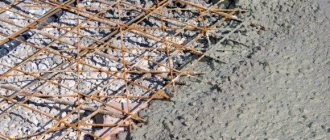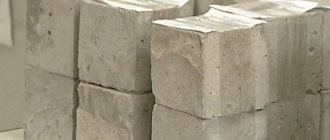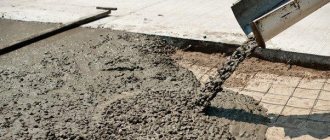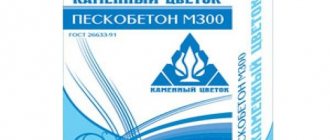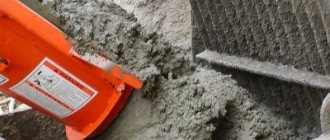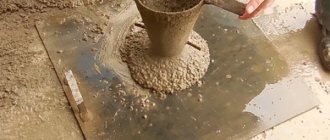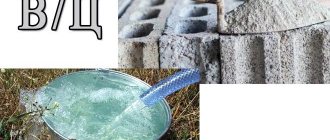What is the mobility of a concrete mixture?
The degree of mobility of a concrete mixture is characterized by its ability to fill formwork and building forms. This property depends on the components used in the concrete, namely:
- Fraction size of crushed stone and sand;
- Brand and quality of cement;
- Availability of additives;
- The ratio of water, cement and fillers;
- Weather and environmental conditions under which the pouring was carried out.
In general, the mobility of concrete, also known as cone shrinkage, is the ability of the mixture to spread over the formwork or other structure being poured due to the material’s own weight.
The mobility of concrete (cone slump) is the ability of the mixture to spread only due to the weight of the material. This property of concrete is very important, along with its strength and other performance characteristics.
Determining the mobility of the concrete mixture will help you choose the right pouring method and calculate the associated resources.
If, during pouring, all the characteristics of the concrete mixture are correctly taken into account, then you can get a strong, reliable and long-lasting structure.
How is it determined?
There are several proven methods used to carry out measurements. For more detailed information, please refer to GOST 10181-2014. We will focus on the simplest and most universal method, which is suitable for both private construction and for pouring large monolithic structures.
In order to set the parameter level for a concrete mixture, a special cone is used to determine the mobility of the concrete mixture. The size of the unit is determined by the dimensions of the crushed stone fraction.
The process of determining the mobility of a concrete mixture using a sediment cone is as follows:
- A metal cone of suitable size is selected;
- It is placed on a flat surface, close to the concrete mixture;
- It is filled with three layers of the test substance;
- Each layer is compacted with a smooth reinforcement bar (5-9 times for each layer);
- The cone is then removed, releasing the solution;
- After a while, experts measure the change in height relative to the top cut of the form;
- The experiment is repeated several times to obtain a more accurate result.
Based on the result obtained, it is possible to establish the mobility grade of the concrete mixture. A strong decrease in the height of the cone characterizes the mixture as mobile, and if the difference in the height of the cones does not exceed 150 mm, the mixture belongs to the group of inactive ones.
There are more accurate methods that require more time. These include measurement with a viscometer and testing in molds.
General technical conditions
Official publication
Moscow Standardinform 2020
GOST R 58766—2019
Preface
- 1 DEVELOPED by the structural division of the Joint Stock Company "SRC "Construction" (JSC "SRC "Construction"): Central Research Institute of Building Structures named after. V. A. Kucherenko (TsNIISK named after V. A. Kucherenko); Scientific Research and Technological Institute of Concrete and Reinforced Concrete named after. A. A. Gvozdev (NIIZHB named after A. A. Gvozdev) and the Joint Stock Company "All-Russian Scientific Research Institute of Certification" (JSC "VNIIS")
- 2 INTRODUCED by the Technical Committee for Standardization TC 465 “Construction”
- 3 APPROVED AND ENTERED INTO EFFECT by Order of the Federal Agency for Technical Regulation and Metrology dated December 13, 2022 No. 1397-st
- 4 INTRODUCED FOR THE FIRST TIME
The rules for applying this standard are established in Article 26 of the Federal Law of June 29, 2015 No. 162-FZ “On Standardization in the Russian Federation”. Information about changes to this standard is published in the annual (as of January 1 of the current year) information index “National Standards”, and the official text of changes and amendments is published in the monthly information index “National Standards”. In case of revision (replacement) or cancellation of this standard, the corresponding notice will be published in the next issue of the monthly information index “National Standards”. Relevant information, notices and texts are also posted in the public information system - on the official website of the Federal Agency for Technical Regulation and Metrology on the Internet (www.gost.ru)
© Standardinform, design, 2020
This standard cannot be fully or partially reproduced, replicated or distributed as an official publication without permission from the Federal Agency for Technical Regulation and Metrology
Content
- 1 area of use
- 2 Normative references
- 3 Terms and definitions
- 4 Classification of mortars
- 5 General technical requirements
- 6 Acceptance rules
- 7 Control methods
- 8 Transportation and storage
Appendix A (recommended) Mobility of the mortar mixture at the site of application
depending on the purpose of the solution
Appendix B (mandatory) Technical requirements for clay intended
for the preparation of mortars
Appendix B (mandatory) Minimum cement consumption in masonry mortar
GOST R 58766—2019
NATIONAL STANDARD OF THE RUSSIAN FEDERATION BUILDING SOLUTIONS
General technical conditions
Mortars. General specifications
Introduction date: 2022—07—01
1 area of use
This standard applies to mortars and mortar mixtures, and mineral binders. used for masonry and installation of building structures during the construction of buildings and structures, fastening facing products, plaster, for installing screeds.
This standard does not apply to special solutions (heat-resistant, chemically resistant, fire-resistant, heat and waterproofing, grouting, decorative, prestressing, etc.) and dry construction mixtures.
2 Normative references
This standard uses normative references to the following standards:
GOST 4.233 System of product quality indicators. Construction. Construction solutions. Nomenclature of indicators
GOST 125 Gypsum binders. Specifications
GOST 2642.5 Refractories and refractory raw materials. Methods for determining iron (III) oxide
GOST 2642.11 Refractories and refractory raw materials. Method for determination of potassium and sodium oxides
GOST 3594.4 Molding clays. Methods for determining sulfur content
GOST 5578 Crushed stone and sand from slags of ferrous and non-ferrous metallurgy for concrete. Specifications
GOST 8735 Sand for construction work. Test methods
GOST 8736 Sand for construction work. Specifications
GOST 9179 Construction lime. Specifications
GOST 10178 Portland cement and Portland slag cement. Specifications
GOST 10180 Concrete. Methods for determining strength using control samples
GOST 10181 Concrete mixtures. Test methods
GOST 18481 Hydrometers and glass cylinders. General technical conditions
GOST 21216 Clay raw materials. Test methods
GOST 22263 Crushed stone and sand from porous rocks. Specifications
GOST 22266 Sulfate-resistant cements. Specifications
GOST 23732 Water for concrete and mortars. Specifications
GOST 24211 Additives for concrete and mortars. General technical conditions
GOST 24544 Concrete. Methods for determining shrinkage and creep deformations
GOST 25328 Cement for mortars. Specifications
GOST 25592 Ash and slag mixtures from thermal power plants for concrete. Specifications
GOST 25818 Fly ash from thermal power plants for concrete. Specifications
GOST 25898 Construction materials and products. Methods for determining vapor permeability and resistance to vapor permeation
Official publication
GOST 26644 Crushed stone and sand from thermal power plant slags for concrete. Specifications
GOST 30108 Construction materials and products. Determination of specific effective activity of natural radionuclides
GOST 30459 Additives for concrete and mortars. Definition and evaluation of effectiveness
GOST 31108 General construction cements. Specifications
GOST R 56592 Mineral additives for concrete and mortars. General technical conditions
GOST R 58277 Dry building mixtures based on cement binder. Test methods
GOST R 58767 Construction mortars. Test methods for control samples
Note - When using this standard, it is advisable to check the validity of the reference standards in the public information system - on the official website of the Federal Agency for Technical Regulation and Metrology on the Internet or using the annual information index "National Standards", which was published as of January 1 of the current year, and on issues of the monthly information index “National Standards” for the current year. If an undated reference standard is replaced, it is recommended that the current version of that standard be used, taking into account any changes made to that version. If a dated reference standard is replaced, it is recommended to use the version of that standard with the year of approval (adoption) indicated above. If, after the approval of this standard, a change is made to the referenced standard to which a dated reference is made that affects the provision referred to, it is recommended that that provision be applied without regard to that change. If the reference standard is canceled without replacement, then the provision in which a reference to it is given is recommended to be applied in the part that does not affect this reference.
3 Terms and definitions
The following terms with corresponding definitions are used in this standard:
- 3.1 ready-to-use construction mortar mixture (mortar mixture): A mixture of binder, fine aggregate, necessary additives and sealer, thoroughly mixed.
- 3.2 mortar: Artificial stone-like material, which is a hardened mortar mixture.
- 3.3 masonry mortars: Mortars and mixtures intended for the construction of masonry from piece masonry products.
- 3.4 installation mortars: Solutions and mixtures intended for performing installation work when installing building structures and products, grouting joints between them, fastening anchors and other work.
- 3.5 facing mortars: Solutions and mixtures intended for finishing the surface of structures of buildings and structures with piece finishing products.
- 3.6 plaster mortars: Mortars intended for leveling walls and ceilings, protecting structures from external influences and imparting decorative properties.
4 Classification of mortars
- 4.1 Construction mortars are classified:
- — for the main purpose;
- - the binder used;
- - medium density.
- 4.1.1 Based on their main purpose, solutions are divided into:
- - for masonry;
- — mounting (8 including for installing screeds);
- - facing;
- - plastering.
- 4.1.2 Based on the binders used, solutions are divided into:
- - for simple ones (on the same type of binder);
- - complex (on mixed binders).
- 4.1.3 Based on average density, solutions are divided into:
- - for heavy ones;
- - lungs.
- 4.2 The designation of a mortar when ordering must consist of an abbreviated designation indicating the degree of readiness (for dry mortar mixtures), purpose, type of binder used, grades for strength and mobility, average density (for light mortars) and the designation of this standard.
An example of a symbol for a heavy masonry mortar, on a lime-gypsum binder, strength grade M100, mobility grade Pk2:
Masonry mortar, lime-gypsum, M100, Pk2, GOST R
5 General technical requirements
- 5.1 Construction mortars must be manufactured in accordance with the requirements of this standard according to technological regulations approved by the manufacturer in the prescribed manner.
- 5.2 For mortars, a distinction is made between the properties of mortar mixtures and the properties of the hardened mortar.
5.2.1 The main properties of mortar mixtures include:
- - mobility;
- — water-holding capacity;
- — delamination;
- — application temperature;
- — average density;
- 5.2.2 The main properties of the hardened solution include:
- - compressive strength;
- — frost resistance;
- — average density;
- — vapor permeability (for plaster and facing mortars);
- — adhesion strength to the base (adhesion) of plaster and facing mortars;
- — frost resistance of the contact zone of plaster and facing mortars (except for mixtures for interior work).
If necessary, additional quality indicators and characteristics of mortars can be established in accordance with GOST 4.233.
- 5.3 Depending on the mobility, mortar mixtures are divided according to Table 1.
Table 1
| Mobility grade G)k | Norm of mobility for cone immersion, cm |
| PC1 | From 1 to 4 incl. |
| PC2 | St. 4 to 8 inclusive. |
| PkZ | St. 8 to 12 incl. |
| PC4 | St. 12 to 14 incl. |
The recommended mobility of the mortar mixture, determined at the site of application, depending on the purpose of the solution, is given in Appendix A.
- 5.4 The water-holding capacity of mortar mixtures must be at least 90%, for clay-containing solutions - at least 93%.
- 5.5 The stratification properties of freshly prepared mixtures should not exceed 10%.
- 5.6 The mortar mixture should not contain fly ash more than 20% of the cement mass.
- 5.7 The temperature of mortar mixtures at the time of use should be:
a) masonry mortars for external work - in accordance with Table 2;
b) facing mortars at a minimum outside temperature, °C, not less than:
c) plaster solutions at a minimum outside temperature. °C, not less:
from 0 to 5……………………………..15;
more than 5…………………………………10.
table 2
| Average daily outside air temperature, °C | Temperature of the mortar mixture. 'C, no less | |||
| Masonry material | ||||
| brick | stones | |||
| At wind speed, m/s | ||||
| UNTIL 6 | over 6 | until 6 | over 6 | |
| Up to minus 10 | 10 | 10 | 10 | 15 |
| From minus 11 to minus 20 | 10 | 15 | 15 | 20 |
| Below minus 20 | 15 | 20 | 20 | 25 |
- 5.8 Standardized quality indicators of the hardened mortar must be ensured at the design age.
The design age of the solution, unless otherwise specified in the design documentation, should be taken as 28 days. for solutions on all types of hydraulic binders.
The design age of solutions without hydraulic binders should be taken as 7 days.
- 5.9 The compressive strength of mortars at design age is characterized by the following grades: M4, M10, M25, M50, M75, M100, M150, M200, M250, M300, M350, M400 and then with an interval of 50.
The compressive strength limits of mortars, depending on the brand, are given in Table 3.
Table 3
| Strength grade | M4 | M10 | M25 | M50 | M75 | M100 | M150 | M200 | M300 | M400 |
| Ultimate compressive strength (average in a series of at least three samples), MPa | 0.4 | 1.0 | 2.5 | 5.0 | 7.5 | 10,0 | 15,0 | 20.0 | 30,0 | 40,0 |
The compressive strength grade is assigned and controlled for all types of solutions.
- 5.10 The frost resistance of solutions is characterized by grades.
The following frost resistance grades are established for solutions: F10, F15. F25, F35, F50, F75. F100.F150. F200.
For mortars of compressive strength grades M4 and M10, as well as for mortars prepared without the use of hydraulic binders, frost resistance grades are not assigned or controlled.
The frost resistance of the contact zone of hardened plaster and facing mortars is characterized by the grades F^S, FK335, FK350, F^S, F^IOO.
- 5.11 The average density of hardened masonry mortars, D, at the design age should be, kg/m3:
- — heavy solutions……………………….from 1500 to 2100;
- - light solutions…………………………less than 1500.
The normalized value of the average density of solutions specified in the supply contract must comply with the design requirements.
- 5.12 The deviation of the average density of the solution towards an increase of no more than 10% from the value established by the project is allowed.
- 5.13 Requirements for materials for the preparation of mortars
5.13.1 Materials used for the preparation of mortars must comply with the requirements of standards or technical specifications for these materials, as well as the requirements of this standard.
- 5.13.2 The following should be used as binding materials:
- — gypsum binders according to GOST 125;
- — building lime according to GOST 9179;
- — Portland cement and Portland slag cement according to GOST 10178;
- — pozzolanic and sulfate-resistant cements according to GOST 22266;
- • cements for mortars in accordance with GOST 25328 and GOST 31108;
- — clay according to Appendix B;
- - other binders, including mixed ones, according to regulatory documents for a specific type of binder.
- 5.13.3 Binding materials for preparing mortars should be selected depending on the purpose of the mortar, the type of structures and their operating conditions.
- 5.13.4 The consumption of cement per 1 m3 of sand in mortars based on cement and cement-containing binders must be at least 100 kg, and for masonry mortars, depending on the type of structure and their operating conditions, no less than that given in Appendix B.
- 5.13.5 The alkali content in cement binders intended for the preparation of plaster and facing mortars should not exceed 0.6% by weight.
- 5.13.6 Lime binder is used in the form of hydrated lime (fluff), lime dough, and milk of lime.
Lime milk must have a density of at least 1200 kg/m3 and contain at least 30% lime by weight.
Lime binder for plastering and facing mortars should not contain unslaked lime particles.
Lime dough must have a temperature of at least 5 FС.
- 5.13.7 The following should be used as a filler:
- • sand for construction work according to GOST 8736;
- — fly ash according to GOST 25818;
- — ash and slag sand according to GOST 25592;
- — porous sands according to GOST 22263;
- — sand from slags of thermal power plants according to GOST 26644;
- — sand from ferrous and non-ferrous metallurgy slags for concrete according to GOST 5578.
- 5.13.8 The largest grain size of the filler should be, mm, no more than:
in masonry mortars (except rubble masonry)
rubble masonry
plaster solutions (except for the covering layer) .2.50; plaster solutions of the covering layer
facing
The presence of sand grains larger than 2.5 mm in size for plaster mortars and larger than 1.25 mm in size for facing and plaster covering mortars is not allowed.
- 5.13.9 When heating aggregates, their temperature, depending on the binder used, should be:
- — cement binder — not higher than 60 °C;
- — cement-lime, cement-clay and clay binders - not higher than 40 °C;
- - lime, clay-lime, gypsum and lime-gypsum binders - not higher than 20 °C.
- 5.13.10 The content of harmful impurities in aggregates should not exceed the values of fine aggregates according to GOST 8736.
- 5.13.11 The specific effective activity of natural radionuclides Aeff in materials used for the preparation of mortar mixtures should not exceed the limit values depending on the area of application of the mortar mixtures according to GOST 30108.
- 5.13.12 Additives to mortars must comply with GOST 24211, GOST R 56592.
Additives are introduced into ready-to-use mortar mixtures in the form of aqueous solutions or aqueous suspensions.
- 5.13.13 Water for mixing mortar mixtures and preparing additives is used in accordance with GOST 23732.
- 5.13.14 Bulk starting materials for mortar mixtures are dosed by weight, liquid components - by weight or volume.
The dosage error should not exceed ±1% for binders, water and additives, and ±2% for aggregates.
For mortar mixing plants with a capacity of up to 5 m3/h, volumetric dosing of all materials is allowed with the same errors.
- 5.14 Labeling, packaging
5.14.1 Mortar mixtures must be accompanied by a quality document.
Ready-to-use mortar mixtures are dispensed into vehicles.
The quality document must contain the following information:
- • name of the manufacturer, its trademark (if any), address and telephone number;
- — symbol and (or) full name of the mortar mixture in accordance with the regulatory document;
- — number of the nominal composition of the mortar mixture;
- — designation of the regulatory document in accordance with which the mortar mixture is manufactured and supplied;
- — the value of the specific efficiency of natural radionuclides A^f according to the results of periodic tests;
- — batch number and date of shipment;
- • amount of mortar mixture, m3;
- — application temperature, °C;
- — grade for compressive strength;
- - mobility grade;
- — frost resistance grade;
- — mark of conformity;
- - type and amount of additive introduced (percentage of binder mass);
- — amount of mixture (for ready-to-use mortar mixtures), m3;
- — date of preparation;
- — results of acceptance tests of the shipped batch of mortar mixture;
- — designation of this standard.
The label and quality document may contain additional information.
The quality document must be signed by the head of the technical control service or another official of the manufacturer responsible for technical control.
6 Acceptance rules
- 6.1 Mortar mixtures must be accepted by the manufacturer’s official responsible for technical control.
- 6.2 Mortar mixtures and solutions are accepted in batches through acceptance and periodic control.
A batch of mortar mixture and mortar is taken to be the quantity of a mixture of the same nominal composition with the same quality of its constituent materials, manufactured using the same technology.
The volume of the batch is established by agreement with the consumer - no less than the output of one shift, but no more than the daily output of the mortar mixer.
- 6.3 All mortar mixtures and solutions are subject to acceptance control according to all standardized quality indicators.
- 6.4 When accepting each batch, at least five spot samples are taken from the mortar mixture.
6.4.1 Spot samples are taken at the place of preparation of the mortar mixture and/or at the place of its use from several batches or places in the container into which the mixture is loaded. Sampling points from the tank should be located at different depths. With a continuous supply of the solution mixture, point samples are taken at irregular intervals for 5-10 minutes.
- 6.4.2 After collection, spot samples are combined into a total sample, the mass of which must be sufficient to determine all controlled indicators of the quality of mortar mixtures and solutions. The selected sample is thoroughly mixed before testing (with the exception of mixtures containing air-entraining additives).
Mortar mixtures containing air-entraining, flax- and gas-forming additives are not additionally mixed before testing.
- 6.4.3 Testing of the mortar mixture should begin no later than 15 minutes after unloading the concrete mixture from the stationary mixer at the manufacturer, and no later than 20 minutes after delivery of the concrete mixture to the consumer.
- 6.5 The mobility and average density of the mortar mixture in each batch is monitored at least once per shift by the manufacturer after unloading the mixture from the mixer.
The strength of the mortar is determined in each batch of the mortar mixture.
Other standardized indicators of the quality of mortar mixtures provided for by this standard and specified in the supply contract (average density, temperature, delamination, water-holding capacity, and frost resistance of the mortar) are monitored periodically, within the time limits established by agreement with the consumer, but at least once every 6 months, as well as when the quality of the starting materials, the composition of the solution and the technology for its preparation change.
- 6.6 Radiation-hygienic assessment of materials used for the preparation of mortar mixtures is carried out according to quality documents issued by enterprises that supply these materials.
In the absence of data on the content of natural radionuclides, the manufacturer must at least once a year, and also with each change of supplier, determine the specific effective activity of natural radionuclides A^^ff of materials in accordance with GOST 30108 in accredited testing laboratories (centers).
- 6.7 Mortar mixtures, ready for use, are dispensed and taken by volume. The volume of the mortar mixture is determined by the output of the mortar mixer or by the volume of the transport or measuring container.
- 6.8 If, when checking the quality of the mortar, a non-compliance with at least one of the technical requirements of the standard is revealed, this batch of mortar is rejected.
- 6.9 The consumer has the right to carry out incoming quality control of construction mortars according to the methods given in section 7.
- 6.10 The manufacturer is obliged to inform the consumer, upon his request, the results of acceptance control tests of shipped batches of mortar mixture no later than 3 days after their completion, and if compliance with the standardized indicator is not confirmed, inform the consumer immediately.
7 Control methods
- 7.1 Samples of mortar mixtures are taken in accordance with the requirements of 6.4, 6.4.1 and 6.4.2.
- 7.2 Materials for the preparation of mortar mixtures during incoming inspection are tested in accordance with the requirements of standards and technical specifications for these materials.
- 7.3 The quality of chemical additives is determined by the effectiveness of their effect on the properties of mortars in accordance with GOST 30459.
- 7.4 The concentration of the working solution of additives is determined with a hydrometer according to GOST 18481 8 in accordance with the requirements of standards and technical specifications for specific types of additives.
- 7.5 The specific effective activity of natural radionuclides AEff in materials for the preparation of mortar mixtures is determined according to GOST 30108.
- 7.6 Mobility, average density, water-holding capacity and stratification of mortar mixtures are determined according to GOST R 58767.
- 7.7 The volume of entrained air in mortar mixtures is determined according to GOST 10181.
- 7.8 The temperature of freshly prepared mortar mixtures is measured with a thermometer, immersing it in the mixture to a depth of at least 5 cm.
- 7.9 Compressive strength, bending tensile strength, frost resistance and average density of hardened solutions are determined according to GOST R 58767.
- 7.10 The tensile strength of the solution during splitting is determined according to GOST 10180 using cube samples of standard size.
- 7.11 Shrinkage deformation is determined according to GOST 24544.
- 7.12 Water separation of the mortar mixture is determined according to GOST 10181.
- 7.13 The adhesion strength of plaster and facing mortars to the base is determined according to GOST R 58277.
- 7.14 Vapor permeability is determined according to GOST 25898.
- 7.15 Frost resistance of the contact zone is determined by the change in the adhesion strength of hardened solutions to the base after the number of cycles of alternating freezing and thawing established for a given brand according to the regime specified in GOST R 58767.
- 7.16 The stability of the properties of mortar mixtures (mobility, medium density, exfoliation) is determined according to GOST R 58767.
Concrete mixture mobility table, cone shrinkage diagram
For clarity, we present to your attention a diagram of the test to establish the mobility grade of the bed mixture.
Thus, if you distribute brands in a table by mobility, it will look like this:
| Mobility grade, P | Cone draft, cm |
| P1 | 1-5 |
| P2 | 5-10 |
| P3 | 10-15 |
| P4 | 15-20 |
| P5 | More than 20 |
Increasing solution mobility
The characteristic under consideration can be improved not only by adding water, but also by increasing the sand fraction and reducing voids.
The properties of mortar mixtures are regulated by replacing rolled sand with sharp-edged sand. In addition, to improve the properties, the thoroughness and duration of mixing the mixture is increased.
https://youtu.be/fghCCjsCylE
If it is necessary to increase the mobility of the mortar mixture without adding water, you can add a plasticizing additive to it, for example, sulfite-alcohol stillage or soap naft
Additives to concrete for mix mobility - which ones can be used?
Depending on what parameter you need to use, the temperature of the working environment and the composition of the concrete mixture, you can select suitable additives that will improve the quality of concrete.
invites you to familiarize yourself with our product range. Low prices, high quality and guaranteed effect of Polytem ® concrete additives.
To increase mobility, additives with a plasticizing effect are suitable:
- Polytem Force®
- Polytem Extra time®
- Polytem NoFrost®
Each of the additives is produced according to a unique formula, which has a positive effect on the overall performance characteristics of concrete mixtures, increases the mobility of the mixture, thereby increasing the strength of structures
Transportation and storage
To transport the solution it is necessary to use special vehicles.
To preserve all the necessary qualities and properties of the solution, it must be properly transported and stored . Of course, first of all, special vehicles must be used for transportation. It is also possible to transport finished material in bunkers, but this is allowed only with the consent of the customer. Do not allow foreign impurities and precipitation to enter the mixture.
When delivering the mixture to the construction site, it must be transferred into special containers, such as mixer loaders or others that meet the required standards. The mortar mixture in dry form (packaged) is transported by road or rail, preventing exposure to precipitation and damage to the packaging.
Store only in dry and covered areas, at a temperature of at least 5°C, while ensuring that high humidity does not form in the room and the seal of the packaging is not broken.
Preparation of masonry mortars
Masonry mortar can be prepared in a concrete mixer with a capacity of 0.15 m3 or manually. Cement mortar is prepared almost similarly to concrete. In a metal or wooden box made of boards 25–30 mm thick with a bottom covered with roofing iron, dimensions 1 × 0.5 m or 1.5 × 0.7 m and a height of 0.2–0.25 m, first fill the required number of buckets in an even layer sand, on top - a full bucket of cement. Next, the mixture is shoveled until the mass is homogeneous in color, poured with a measured amount of water from a watering can and continued shoveling until a homogeneous composition is obtained. . The prepared solution must be consumed within 1.5 hours so that it does not lose strength.
To prepare the solution, sand must first be sifted through a sieve with 10x10 mm cells (for masonry). Read about the ratio of sand and cement for mortars and plaster - Here. A solution of lime paste is prepared immediately, mixing it with sand and water until smooth. Cement-lime mortar is prepared from cement, lime paste and sand. Lime dough is diluted with water to the consistency of milk and filtered on a sieve with 10x10 mm cells. A dry mixture is prepared from cement and sand and mixed with lime milk to the required thickness (dough consistency). Cement-clay mortar is prepared similarly to cement-lime mortar.
Application of mortars
- Cement mortars are often used in stone and brickwork in cases where the structure is located below the groundwater level, as well as for plastering plinths, external walls, cornices, and pouring floor screeds. For rooms with humidity above 60% this is the optimal type of mortar.
- Clay mixtures are usually used as masonry - for pipes, hearths and stoves, as well as for the ground part of buildings that are not exposed to moisture. The plasticity of the material causes a low degree of shrinkage, however, such a composition hardens relatively slowly.
- Complex mortars - which contain several types of binders - are most popular due to the fact that they have the advantages of mixtures based on various components. They also have higher strength compared to simple mortars and are widely used for masonry and plastering work. Cement-lime mixtures are most often used in this category.
Cement mobility: impact on concrete pouring technology
The mobility of a specific batch of concrete or cement mortar determines the technological map and ease of construction. In particular, it is regulated whether vibration and compaction with special equipment will be used, or whether “bayoneting” will be sufficient.
For example, the use of concrete pumps and feed chutes is possible only with a certain (high) degree of mobility. In other words, the mobility of cement affects the strength of the final product, the speed of pouring, the convenience of pouring and the cost of construction. Properly selected cement mobility is especially important during the construction of large-scale projects.
Factors affecting cement mobility
- Binder (cement). With an increase in the “master-binder” proportion, the mobility increases sharply. In this case, the strength of the final product decreases sharply, and after reaching the “water retention” value, the solution will generally begin to delaminate. Therefore, to increase mobility, it is recommended to add additional cement. In this case, the thickness of the “cement paste” layer between the filler elements increases. “Cement paste” begins to perform the function of a lubricant - mobility increases, but the cost of construction increases significantly;
- Filler (crushed stone, gravel, slag, etc.). The mobility of the solution is directly dependent on the geometry of the filler elements. When using “crushed” filler with an angular surface, mobility is minimal. At the same time, if gravel is used as a filler, due to its “streamlining and roundness,” the mobility of the solution increases, but the strength of the structure decreases.
The mobility of concrete is directly affected by the pouring conditions: the height of the structure, the shape of the structure, the presence of free access from all sides and the size of the cells of the reinforcing belt.
If the height of the structure is decent, its shape is irregular, the cell sizes are small, and there is no space around the formwork to place vibrators, in order to avoid the appearance of leaks, voids and cavities, highly mobile solutions P4 or P4 are used.
Application of concrete and cement mortar depending on the type of mobility
- Hard. Very rarely used. In private low-rise housing construction it is not used at all;
- Sedentary. Used for pouring monolithic concrete products with the mandatory use of vibration with special equipment;
- Highly mobile. They are used for the construction of reinforced structures in conditions where vibration and compaction are difficult: high foundations, columns, monolithic walls, etc. The solution, which has P4 mobility, is optimal for the construction of any structures and does not require vibration and compaction.
